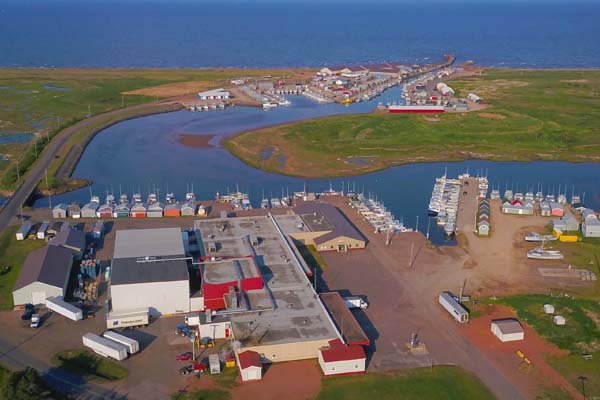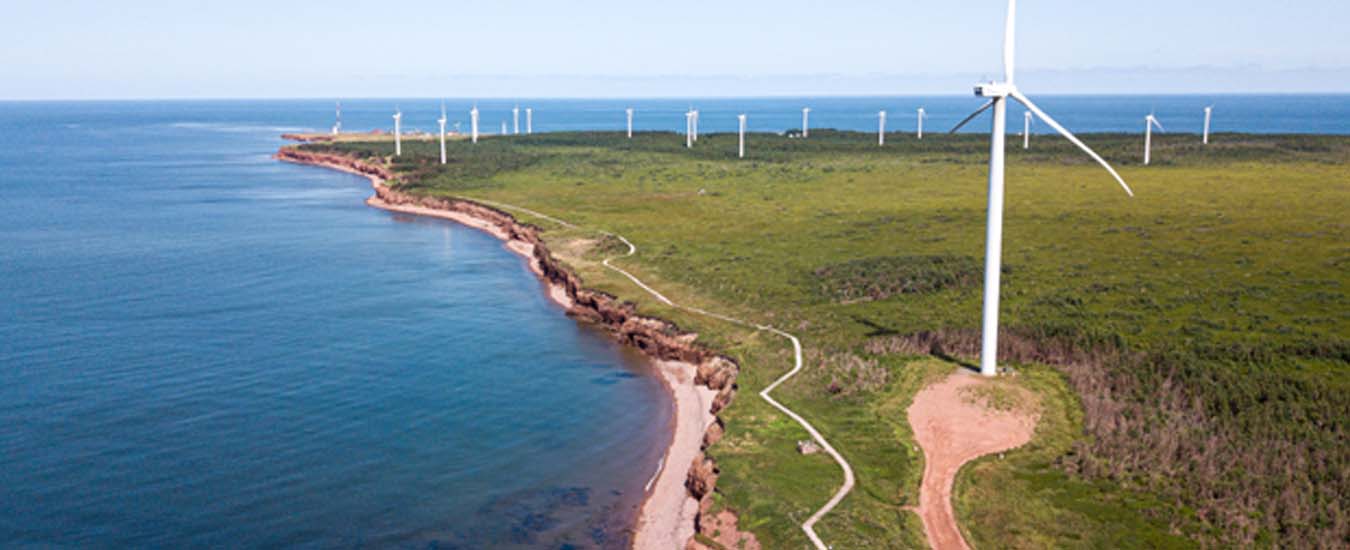The namesake of a Martian crater?
A magnet for international workers?
A marvellous way with words?
Why wouldn’t you move to Tignish?
Planted at the far northwestern tip of Prince Edward Island, it may derive its name from the Mi’kmaq word Mtagunich which means “paddle”. No one really knows. But, if you have an hour or two to spare, someone here will tell you anyway.
Someone will also speculate on why the town is the namesake of a crater on the planet Mars, headquarters to one of the first working wind farms in Canada, ground zero for one of the most successful commercial fishery operations in Atlantic Canada, and host to one of the largest populations of Filipinos in the Maritimes.
That’s Tignish, and in Tignish nothing fuels a conversation better than a good riddle. Except those from here might say “raddle” or “ruddle”. Again, no one knows exactly why. But Joanne Leclair-Perry may have a clue.
“Maybe you’ve heard about the Tignish slang,” says the effusive come-from-away (Toronto), who came to stay in 1986 when she and her native-born-and-raised husband Tommy took over his parents’ general store on the town’s main drag.
Retired now, with two grandsons, Perry spends whatever time she can moderating the Facebook Group “Tignish Talks”. For a while, during the dark days of COVID, she featured a special video segment starring her husband and a friend, Paul Shea. “When everyone was down on their luck and depressed and all that, Tommy and Paul would take a common word and say it in a different way pertaining to a different meaning,” she says. “It was sort of a daily thing.”
February 12, 2021. Word of the Day: Simulator.
Tommy: “You still got that walk-behind snowblower there?”
Paul: “Yeah. Big 25-inch Craftsman.”
Tommy: “I should pick it up off you…What do you want for it?”
Paul: “Just come and get it, use it for a while, and you can si-mu-lator.”
Simulator. See-me-later. Get it?
Okay. It’s an acquired taste. But, increasingly, it seems there’s much about Tignish and the Island’s western communities on the Gulf of St. Lawrence that people both from this country and the other side of the world want to acquire.

Osprey Cove Productions
Tight-knit Tignish
As other small towns in the Maritimes watch their cultural and economic foundations crumble, Tignish is laying cornerstones for new infrastructure and international attention. Thanks to a robust fishery that never received the Government of Canada memorandum about cutbacks, the town has opened its doors to foreign workers—notably from the Philippines—many of whom are now permanent residents or Canadian citizens. Tignish has somehow managed to do this without engendering the usual tropes about strangers stealing jobs from locals.
Perry thinks she knows why.
“I worked at the Eaton’s buying office in downtown Toronto for 12 years,” she says. “So, believe me, Toronto and Tignish are like night and day. I love it a lot here. It’s an extremely caring, close-knit community—a community that would give to you, especially during sickness. We live at the tip of the Island, so there’s no local hospitals. We would have to travel to Summerside or Charlottetown or Halifax or Moncton.”
In other words, the more Tignishians talking, the better.
“Paul and I met a lady from Australia in a McDonald’s [restaurant] in Summerside,” Tommy says. “She’s formerly from the Island, but she’d been away for 15 or 20 years, and she said she never missed a ‘Word of the Day’. Then, her Australian husband said, ‘I don’t really get some of that, ’cause I don’t understand what you’re saying.’ So, I said, ‘Well I don’t [bleeping] understand what you’re saying, either’.”
History’s influence
Reg Porter, who lives in the area and writes a blog on Island heritage, chalks up at least some of Tignish’s particular bonhomie—its habit of seeing itself as both isolated and in the middle of everything, simultaneously—to history.
“In 1765, the British government—wanting to make the perfect colonial dream based on the English system of feudalism—got Samuel Holland [British army engineer and captain in the Royal Navy] to survey the Island,” he says.
“Holland then divided it into 67 townships of 1,000 acres each. These lots were to be awarded to various English people who had political patronage and who had helped finance the [Seven Years War against France]. Holland, being incredibly honest, described the qualities of Lot One as not being very good for anything. Tignish was located in Lot One.”
Starting in the 1790s, French and Irish immigrants arrived. According to the town’s website, “Tignish was originally settled by eight Acadian families who came by boat in 1799 from the Malpeque area of PEI. They lived on the coast in an area referred to as ‘The Green’. Later in 1811, [they] were joined by Irish immigrants. Sometime later, and for various reasons (one of which was where the CN Rail decided to put their terminal) the Acadians and Irish moved inland to cluster around the end of the railway.”
They’ve been living and working together ever since. And, of course, talking.
“Tignish wasn’t a community that passed on knowledge in writing,” Porter says. “Everything was by word of mouth. That was the way people communicated.”
To a great degree, it still is.
World class fisheries
“The only thing I don’t like around here is the cell phone service,” says Francis Morrissey, the plain-spoken CEO and general manager of Royal Star Foods, a subsidiary of Tignish Fisheries Co-op Association, whose 237 members fish exclusively for the company. The co-operative, he notes, was formed nine years ago specifically to support the shared economic and commercial ambitions of the community. Everyone pitches in; everyone benefits. And benefit, they do.
“We have a 95,000-square-foot processing plant, which has three cold storages attached,” Morrissey says. “We have a spring and a fall fishery. Our members fish a combination of lobster, snow crab, herring, and mackerel. And, following all that, we have a massive tuna fishery….We have a great workforce of between 380 and 420 people, which we run about 10 months of the year.
All of which has helped Royal Star live up to its name in a notoriously capricious and competitive industry. According to an article in The Canadian Business Journal last year, the company’s global sales model involves dealing with “larger brokers and some wholesalers. Seventy-five per cent of [its] products end up at larger restaurant chains like Red Lobster [and] Outback Steakhouse...Lobster represents Canada’s most valuable seafood export, and made up $924,173,663 of export value in 2008.[Royal Star] turns over $30-35 million in revenue a year.”
Or, as Morrissey says, more simply: “Yeah, we’re known all over the world.”
The Martian connection
Of course, Tignish’s other claims to fame also grab global attention. It’s the official headquarters of The Wind Energy Institute of Canada, a not-for-profit organization formed in 1981 to research, test, innovate and collaborate with industry. It even has a heavenly feature named after it—UCGS-MC-28—thanks to the International Astronomical Union in 1991.
“When they get to Mars, future Canadian astronauts won’t find a Tim’s waiting for them, but if they’re lonesome they can always touch down in Tignish,” the Calgary Herald reported in 2008. “Tignish being [a] crater…and among 75 geographic features on planets and moons in our solar system named for Canadians or Canadian places…The Martian crater Gander is in the southern hemisphere of the red planet. The Tignish crater is just west of Gander.”
Laying down roots
But, for sheer reputation-burnishing in far-flung places nothing else in town matches Royal Star’s people-first approach to the fishery. Since the co-op’s founding, dozens of foreign temporary workers from the Philippines have laid down roots in and around the town, instant-messaging and texting their experiences to the smart phones of friends and relations from Manila to Davao City. And Morrissey makes no apologies for the employment plan.
“When we started, our local population was dropping in the community. The workforce was drying up,” he says. “These people may have come in here as temporary foreign workers,” he says. “But they are not immigrants anymore. They are permanent residents and many of them are citizens of Canada.”
Still, he says, “We went about it the hard way. We went to the first ones we brought in and said, ‘Look, bring your family, your friends, whoever, so you’re not lonely.’ But, frankly, we really didn’t know how it was going to work.”
In fact, for Marian Eliot, who arrived in 2016 for a job on the plant’s production floor, it’s worked out pretty well.
“I’m from the Philippines, but I actually came here from [a hotel office position] in Dubai,” she says. “At first, it was very hard working all day at the fish plant…very challenging. But I had a goal. I wanted to be a Canadian citizen. So, I said, ‘Do whatever it takes to come to Canada.’ After a year, I was given the chance to do inventory. Then, I was an inventory clerk for three or four years. Now I work in the main office, doing training for costing.”
What’s more, she has qualified for citizenship. “I’m just waiting for the ceremony,” she says. “I have six family members already here. Most of the workers here are permanent residents.”
“People first” policy
Says Morrisey: “Before we started bringing people in here, 50 per cent of the lights in the town were out. There was nobody in the houses. Well, an awful lot of our workers [from the Phillipines] now have families here, and they own houses.”
Has Eliot found a new home? “I came here maybe as a way to settle into a big city,” she says. “But I have a son and experiencing how warm people are here, I now think it’s the best place to raise a child. I want my son to grow up here in Tignish.”
Former Torontonian Joanne Leclair-Perry can relate. “I mean, we started here when we bought the store, and we only had three employees besides my husband and I. And 32 years later, when we sold the business, we had 19 employees. So, that’s how much it grew. And I loved it too.”
Tignish was where all her important changes happened.
“We only have one daughter,” she says. “But she said it was amazing, when she was in university, how many people would always, always laugh with her because she had this Tignish slang. Like, I don’t even know what it is, really, or what it sounds like.
“Maybe I’ve been living here too long. I don’t know. Maybe I have no idea. But I know that people from away often say that we speak with it.”
Like a mark of belonging, a prelude to hospitality.
All of which is music to the ears of people like Judy Morrissey, Francis’s sister and Tignish’s deputy mayor (it is a small town, after all). Sure, new problems go along with commercial growth, economic stability and social cohesion. But, they’re all good problems, and they’re certainly better than the alternative.
“Right now, finding a place to rent in Tignish is next to impossible,” she says. “We actually have developers coming from Charlottetown to start two 12-unit apartment buildings. And, like, we’re welcoming them. We met with them. We went over everything with them. We’re accommodating them as best we can, like whatever they need to get them here.”
Indeed, nothing beats a good chin wag to solve any riddle, or “ruddle”.
This is Tignish, after all.
